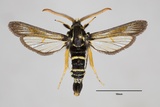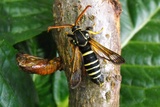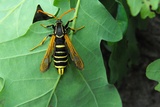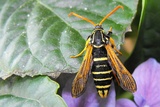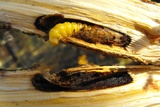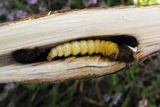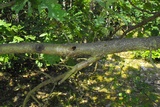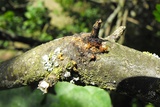Paranthrene insolitus Le Cerf, 1914 Species
Last modified: Nov. 21, 2025, 6:19 p.m.
This species, which had been suspected for some time to also occur in Belgium, was observed for the first time in 2021 in LX.
Details
- Classification
- Family: Sesiidae > Subfamily: Sesiinae > Tribus: Paranthrenini > Genus: Paranthrene > Species: Paranthrene insolitus
- Vernacular names
- Eikentakwespvlinder (NL), Sésie polonaise (FR), Eichenzweig-Glasflügler (DE)
- First mention in Belgium
- Garrevoet Theo 2022. Paranthrene insolitus (Lepidoptera: Sesiidae), een nieuwe wespvlindersoort voor België — Phegea 50(2): 69-72. On page 69.
- Status
-
Native
Distribution
Imago
This species is a rather large one (23 – 32 mm) and differs from P. tabaniformis by the brown forewings with the clear presence of an outer transparent area (ETA) on the forewing that is missing in the completely black forewings of P. tabaniformis. The antennae are orange-brown and rather strongly pectinated. The proboscis is short and not functional while it is fully developed and functional with P. tabaniformis. There is a yellow V-shaped transverse line on the metathorax and the tegulae are also clearly bordered with yellow. With P. tabaniformis there are only some yellow spots near the base of the wings.
The abdomen is black dorsally with distinct yellow bands on segments 2 and 4–7 at the ♂ and segments 2 and 4–6 at the ♀. With P. tabaniformis, the yellow band on segment 5 is missing. The anal tuft is black with clear yellow hair-scales centrally and on both dorsal sides while it is completely black with the other species of this genus.
The males are attracted from early to late afternoon to the pheromone developed for this species. But also the pheromone originally developed for S. myopaeformis attracts P. insolitus fairly well.
Flight periods
According to the current observations, the adults fly in Belgium from mid-June till mid-July.
Observed on
- Host plant (species):
- Quercus robur, Quercus petraea and
- Host plant (genera):
- Quercus
The larva lives in the branches of Quercus species.
Habitat
The species is bound to warm, wind-sheltered biotopes in open woodlands or along forest edges with sun-drenched oak trees where it lives in the treetops. But also on lower branches of trees facing south and even relatively young trees are not despised.
